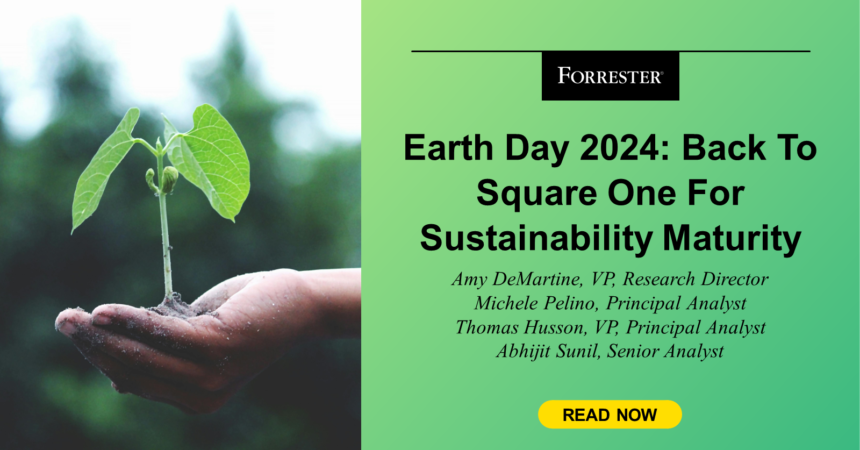It’s been three years since we introduced Forrester’s first Sustainability Maturity Model. Although the model still holds, a lot has changed over the past three years with respect to how organizations create successful environmental sustainability programs and the maturity needed to get there. It seems like every week a new regulation is announced. The fallout is that everyone is rethinking their maturity. But despite challenges, sustainability maturity reaps rewards. Schneider Electric generates 74% of its revenue with what it calls “impact products.” And Patagonia — the company that many try to emulate — is still going strong, with an estimated value of about $3 billion and bringing in $100 million in revenue annually.
So what is environmental sustainability maturity? It is the journey that your company is on to attract green consumers, grab investor attention, and better the planet (and all of us on it) along the way.
Our maturity model enables companies to assess their maturity across five levels (compliance, commitment and roadmap, operational excellence, disruptive innovation, and future-generation safe), see the benefits/investments of each, and plan for the needed organizational commitments. Using the maturity model, organizations — firms, government agencies, countries, and cities — can map their way to an environmental sustainability transformation.

For Earth Day 2024, we’ve updated the model. Some elements haven’t changed, but for others, the changes are drastic. What brings us back to square one? New regulations that demand that companies continuously reassess compliance. They’ve also reset the bar for what must be achieved. Get ready to begin once again, and of course, this won’t be the last time you’re starting over. What were the biggest changes?
- Every company has to make their own high-water mark. The name of the game is now either to take steps to comply for the first time or to take steps to fill any compliance gaps. Because each regulation is geared toward the problem in environmental sustainability that it’s trying to solve, there isn’t just one to which you can comply. It’s up to your organization to understand what regional, country, and even state regulations apply and then cobble together the combination of requirements that you will need to meet. Regulations are still in flux, so be ready to adjust or begin again.
- Execs must now be engaged in compliance. It’s no longer good enough to put out a yearly or quarterly sustainability statement to appease green consumers or investors. Regulations require that execs be accountable for the strategy and reporting that they expose. Think liable.
- Strategy must be communicated at compliance. It used to be that you could wait for commitment and create a broad strategy with targets that you didn’t know you could meet. Now, regulations demand that you expose your strategy at compliance, which means that what you say counts (remember the liable bit?).
- Pay incentives might not kick in until the commitment and roadmap level or higher. Accountability is the stick; pay incentives are the carrot. While accountability is now firmly in compliance, pay incentives for achieving goals won’t be set until your organization has at a minimum set its targets. By the time you reach disruptive innovation, these pay incentives will be commonplace, in addition to the metrics and KPIs that dictate internal accountability.
- Deep knowledge of the supply chain is a must at the operational excellence level. You are dependent on your supply chain to create your products and services. That means that your supplier’s energy use, materials usage, and waste production liabilities become your own. But even this bar has raised. You must now have a strong code of conduct with your supply chain that includes things like not using child labor.
- Planetary boundaries are key to reach the future-generation safe level. Even if you aren’t a sustainable-native organization, you can start now by understanding which of the nine planetary boundaries (e.g., freshwater usage, ozone depletion) your organization wants to address, what targets to set, and how to measure whether you’ve met them. And don’t forget to reevaluate the latest thinking and best practices about what organizations have in their control.
Use Earth Day 2024 to reassess your organization’s maturity and path toward being future-generation safe and the benefits available along the way. If you are a Forrester client, be sure to check out our latest, Guide Your Environmental Sustainability Program With The Forrester Sustainability Maturity Model, or better yet, take the new assessment after reading Gauge Your Environmental Sustainability Maturity.
As always, we are available via inquiry and guidance sessions to walk you through the maturity assessment or to dig into topics such as how to set and structure pay incentives. Schedule time with any of us to talk more.








